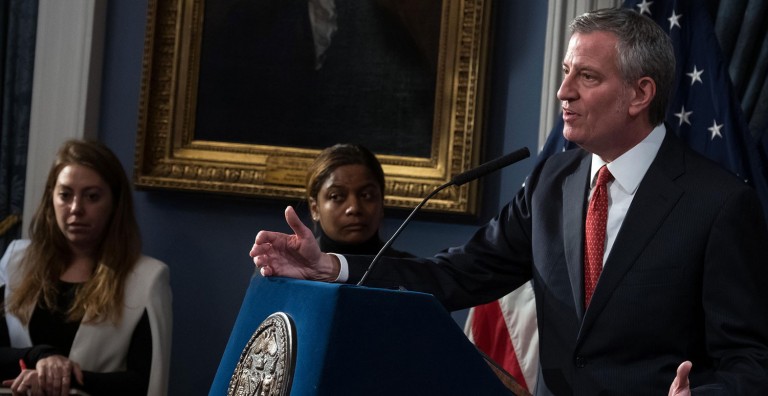Photo Courtesy of Ed Reed/Mayoral Photography Office
The FY2020 Preliminary Budget “makes modest investments that continue to make New York City the fairest big city in America” while providing services to all residents, Mayor de Blasio said.
By Michael V. Cusenza
Though economic indicators point to looming stagnation, Mayor Bill de Blasio on Thursday presented a $92.2 billion Fiscal Year 2020 Preliminary Budget.
In comparison, last June, de Blasio and City Council Speaker Corey Johnson announced an agreement on a balanced $89.16 billion budget for FY2019.
The mayor touted the new spending plan as one that demonstrates fiscal responsibility and caution in the face of uncertainty in Washington, D.C., potential cuts and cost shifts from Albany, and a possible economic slowdown. Additionally, de Blasio said, the budget “makes modest investments that continue to make New York City the fairest big city in America” while providing services to all residents. Hizzoner noted that the plan sets a savings goal of $750 million which he claimed will be achieved in part by deepening the City’s partial hiring freeze and implementing his administration’s first Program to Eliminate the Gap – a procedure used to close a budget gap when government expense eclipses revenue.
De Blasio cautioned on Thursday that the City faces economic uncertainty from several angles. Albany is threatening to impose $600 million in budget cuts and shifts that may impact NYC’s ability “to educate our children, provide financial assistance to families in need, and deliver health services to vulnerable New Yorkers,” he said. Uncertainty in Washington D.C. also is a substantial concern, de Blasio warned.
Additionally, tax revenues are coming in at a slower pace than last year, according to the mayor. The City now projects that Personal Income Tax revenue will be $935 million less than last year.
However, de Blasio also hailed his administration for the following “modest investments” featured in the FY2020 spending plan:
• Guarantee healthcare access for 600,000 uninsured New Yorkers by investing $25 million, growing to $100 million at full ramp up, for NYC Care, which is set to launch in summer of 2019 in the Bronx and across NYC in 2021.
• Invest $106 million in FY2020 for the Fair Fares program which provides half-priced MetroCards to low-income New Yorkers.
• Accelerate NYPD Crisis Intervention Training for patrol officers most likely to respond to mental health-related emergencies, totaling $5.3 million.
• Deepen our investment in 3-K for All by adding $25 million for two new districts in the Bronx and Brooklyn, which will bring the total number of kids starting this fall to 20,000. With these two new districts, there will be a total of 14 3-K for All districts by September 2020. The City will now be serving the 10 highest-need districts in the city.
• Invest $2.7 million annually towards the goal of speeding bus service by 25 percent by December 2020. The Department of Transportation will give buses green light priority at 300 new intersections per year, helping them stay on schedule.
“Even while recognizing the challenges, we also know this City’s economy is strong and we will fight
for a fiscally responsible plan that protects the social safety net,” the City Council said of the FY2020 Preliminary Budget in a joint statement by Speaker Corey Johnson, Finance Committee Chairman Daniel Dromm, and Capital Budget Committee Chairwoman Vanessa Gibson. “The council will detail our
priorities, ways to save money and ensure that critical past investments are not diminished.”
City Comptroller Scott Stringer said smarter fiscal belt-tightening is needed.
“To ensure we can always provide a strong social safety net means also preparing the City for potentially tougher times ahead. That’s why we cannot continue to spend $3 billion a year on homelessness—without reducing the homeless population. That’s why we cannot continue to spend more money at Rikers Island for fewer detainees—but see violent incidents rise ever higher,” he added.

